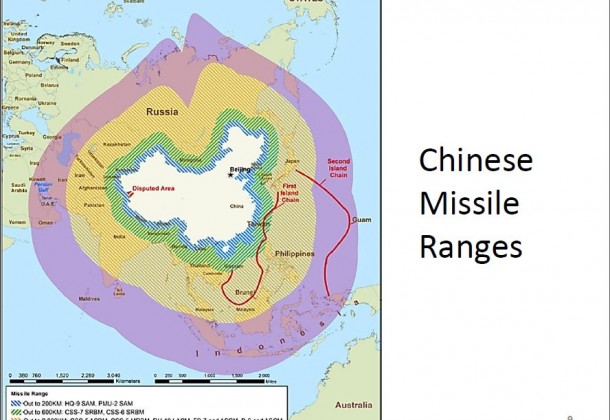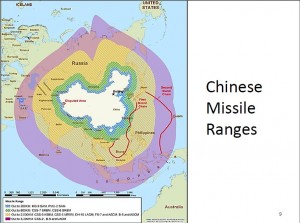Military & Security in China: A Primer

The Patuxent Partnership’s strategic planning series opened its 2014 season with an update of the immediate and future military and security strategies of the People’s Republic of China.
Dale Moore, a lead strategic thinker for NAVAIR and NAWCAD, presented a concise breakdown of how China’s military expects to dominate the world’s cyber stage and the Pacific as it grows its own defense economy.
The full presentation from The Partnership’s program last month additionally includes a section on NAVAIR initiatives and strategies.
Here is an abridged version:
Military and Security Developments Involving the People’s Republic of China 2013
China Weapons Overview: China is investing in military programs and weapons to improve extended operations and power into emerging domains such as cyber, space, and electronic warfare.
Weapon production includes ballistic missiles, anti-ship and land attack cruise missiles, nuclear submarines, modern surface ships, and an aircraft carrier.
Reliance on foreign weapons acquisitions is decreasing as domestic defense-industrial and research bases mature, however, in the immediate, foreign assistance is needed to fill critical near-term capability gaps. Foreign arms acquisition comes particularly from Russia and the Ukraine.
Espionage for military modernization includes economic espionage, theft of trade secrets, export control violations, and technology transfer.
China’s Priorities and Goals consider the first two decades of the 21st century as a “strategic window of opportunity” and conducive to expanding China’s “comprehensive national power,” which includes economic capacity, military might, and diplomacy.
China regards stable relations with its neighbors and the US as essential to its stability and development.
Despite its desire to project an image of a developing country engaged in a peaceful development strategy, China’s efforts to defend national sovereignty and territorial integrity have occasionally manifested in assertive rhetoric and behavior that has generated regional tensions.
China’s Long-term Goal is a a wholly-indigenous defense industrial sector augmented by a strong commercial sector to meet the needs of military modernization.
China’s publicly-disclosed military budget, 2003-12, averaged 9.7% annual growth, a rate considered sustainable even with lowered overall economic growth forecasts. In March 2013 China announced a 10.7% increase in its annual military budget to $114 billion.
The US estimates China’s total military-related expenditures for 2012 fall between $135 and $215 billion.
PLA Future Capabilities:
- Nuclear Weapons – China will likely continue to invest considerable resources to ensure it can deliver a damaging, retaliatory strike.
- Future Efforts – A range of technologies to counter U.S. and other countries’ ballistic missile defense systems
- Anti-Access / Area Denial – China continues to develop measures to deter or counter third-party intervention, particularly by the US; A2/AD is focusing on the capability to attack, at long ranges, military forces that might deploy or operate within the western Pacific
- Developing air, sea, undersea, space and counter-space, and information warfare systems and operating concepts for multi-layered offensive capabilities
- Seek “information blockade” or “information dominance” in early phases of a campaign
- Fielding conventionally armed ballistic missiles, ground-and air-launched land-attack cruise missiles, special operations forces, and cyber-warfare capabilities to hold targets at risk throughout the region.
China’s Defense Industry seeks technological breakthroughs, including radar, counter-space capabilities, secure C4ISR, smart materials, and low-observable technologies. The 16 major items sought for development or expansion of indigenous capabilities, include core electronic components, high-end universal chips and operating system software, very large-scale integrated circuit manufacturing, next-generation broadband wireless mobile communications, high-grade numerically controlled machine tools, large aircraft, high-resolution satellites, and lunar exploration.
Science and Technology Development Goals Through 2020
Basic research Material Design and Preparation Manufacturing in Extreme Environmental Conditions Aeronautic and Astronautic Mechanics Information Technology Developments Nontechnology ResearchLeading-edge technologies
- Information Technology -perception technologies, ad hoc networks, and virtual reality technologies.
- New Materials -smart materials and structures, high-temperature superconducting technologies, and highly efficient energy materials technologies;
- Advanced manufacturing -extreme manufacturing technologies and intelligent service advanced machine tools;
- Advanced energy technology, marine technologies-include hydrogen energy and fuel cell technologies, alternative fuels, and advanced vehicle technologies;
- Marine Technologies -three-dimensional maritime environmental monitoring technologies, fast, multi-parameter ocean floor survey technologies, and deep-sea operations technologies;
- Laser and aerospace technology-include development of chemical and solid laser state technologies to ultimately field a weapons-grade system from ground-based and airborne platforms.























